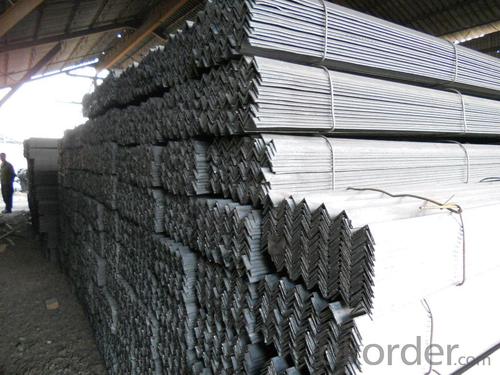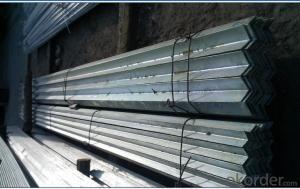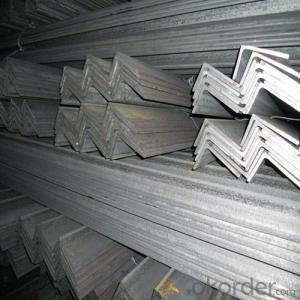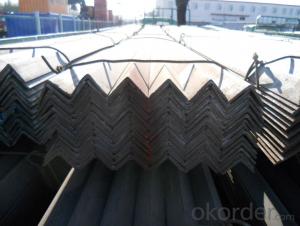Equal Steel Angle Q235/Q345
OKorder Service Pledge
OKorder Financial Service
You Might Also Like
Specifications of Equal Angle Steel
1.Standards:GB
2.Length:6m,9m,12m
3.Material:GBQ235,Q345 or Equivalent
4. Size:
Size (mm) | Mass (mm) | Size (mm) | Mass (mm) |
| 38*38*3.8 | 2.19 | 38*38*5 | 2.82 |
| 38*38*4 | 2.297 | 38*38*6 | 3.326 |
Usage & Applications of Equal Anlge Steel
Trusses;
Transmission towers;
Telecommunication towers;
Bracing for general structures;
Stiffeners in structural use.
Packaging & Delivery of Equal Angle Steel
1. Transportation: the goods are delivered by truck from mill to loading port, the maximum quantity can be loaded is around 40MTs by each truck. If the order quantity cannot reach the full truck loaded, the transportation cost per ton will be little higher than full load.
2. With bundles and load in 20 feet/40 feet container, or by bulk cargo, also we could do as customer's request.
3. Marks:
Color mark: There will be color marking on both end of the bundle for the cargo delivered by bulk vessel. That makes it easily to distinguish at the destination port.
Tag mark: There will be tag mark tied up on the bundles. The information usually including supplier logo and name, product name, made in China, shipping marks and other information request by the customer.
If loading by container the marking is not needed, but we will prepare it as customer request.
*If you would like to get our price, please inform us the size, standard/material and quantity. Thank you very much for your attention.
- Q: Can steel angles be used in marine environments?
- Yes, steel angles can be used in marine environments. However, it is crucial to select the appropriate grade of stainless steel or corrosion-resistant coating to prevent corrosion and ensure durability in the harsh marine conditions.
- Q: How do you protect steel angles during transportation?
- To protect steel angles during transportation, it is important to use proper packaging and secure them tightly to prevent any movement or shifting. This can be achieved by using sturdy crates or pallets, wrapping them in protective materials such as foam or bubble wrap, and using straps or bands to secure them in place. Additionally, ensuring that the angles are properly cushioned and avoiding contact with other sharp or abrasive materials will help prevent any damage or scratches.
- Q: What are the different types of connections used for steel angles in steel frames?
- There are several types of connections used for steel angles in steel frames, including welded connections, bolted connections, and riveted connections. Welded connections involve fusing the angles together using heat, creating a strong and permanent bond. Bolted connections involve using bolts and nuts to secure the angles together, allowing for easy disassembly if necessary. Riveted connections involve using rivets, which are metal pins, to hold the angles together by forming a permanent, tight fit. The choice of connection type depends on the specific requirements of the steel frame and the desired level of strength and durability.
- Q: How do steel angles perform in terms of water resistance or waterproofing?
- Steel angles typically do not have inherent water resistance or waterproofing properties. Since steel is a metal, it is susceptible to corrosion and rust when exposed to water or moisture for extended periods of time. However, the water resistance or waterproofing of steel angles can be improved through various measures. One common method is to apply a protective coating, such as galvanizing or painting, to the steel angles. Galvanizing involves coating the steel with a layer of zinc, which acts as a barrier against water and prevents corrosion. Painting, on the other hand, creates a protective layer that helps to seal out moisture and prevent direct contact between the steel and water. Additionally, proper design and installation techniques can also enhance the water resistance of steel angles. For example, ensuring proper drainage and avoiding water accumulation on or around the steel angles can prevent long-term exposure to moisture, reducing the risk of corrosion. It is important to note that even with these measures, steel angles may still be susceptible to water damage if the protective coatings become compromised or if there is constant exposure to harsh environmental conditions. Regular inspection, maintenance, and prompt repair or recoating of the steel angles are essential to ensure long-lasting water resistance.
- Q: Can steel angles be used for framing or supporting exterior façade elements?
- Steel angles have the capability to be utilized in framing or supporting exterior façade elements. In the construction industry, steel angles are frequently employed due to their robustness and endurance. They offer a steadfast and dependable support system for various architectural elements, particularly exterior façade elements. Steel angles can be employed to construct windows, doors, and other openings in the exterior walls. Furthermore, they can be utilized to enhance and sustain the weight of exterior cladding materials such as stone, glass, or metal panels. Steel angles exhibit versatility and can be effortlessly customized to suit the specific requirements of the project. They are often preferred in commercial and industrial buildings where structural stability is of utmost importance.
- Q: Can steel angles be used in the construction of religious institutions?
- Yes, steel angles can be used in the construction of religious institutions. Steel angles are versatile and commonly used in construction due to their strength, durability, and ability to withstand heavy loads. They can be used to provide structural support and stability to the building, ensuring its longevity and safety. Whether it is for columns, beams, trusses, or framing, steel angles can be effectively utilized in the construction of religious institutions to meet the specific design and engineering requirements.
- Q: What are the properties of steel angles?
- Steel angles have several properties that make them highly versatile and widely used in various industries. Firstly, they have excellent strength-to-weight ratio, providing structural stability and support. Secondly, steel angles offer great resistance to corrosion and impact, ensuring durability in different environments. Additionally, they have high malleability and ductility, allowing for easy fabrication and shaping to meet specific design requirements. Lastly, steel angles possess good thermal conductivity and are fire-resistant, making them suitable for applications where heat transfer and fire protection are crucial.
- Q: What is the maximum length of a steel angle available in the market?
- The maximum length of a steel angle available in the market can vary depending on the supplier and the specific type of steel angle being referred to. However, in general, steel angles are typically available in lengths ranging from 20 feet (6.1 meters) to 40 feet (12.2 meters). It is important to note that these lengths are commonly found for standard steel angles, but there may be customized options available that could exceed these lengths if required for specific projects or applications. It is advisable to consult with the supplier or manufacturer to determine the maximum length available for a particular steel angle.
- Q: Can steel angles be used for bracing?
- Certainly! Bracing can be achieved using steel angles. These angles are widely employed in construction and engineering ventures to furnish structural support and reinforcement. Their versatility allows for effortless welding or bolting, rendering them adaptable to diverse applications, including bracing. Owing to their inherent strength and rigidity, steel angles excel at bestowing stability and withstanding lateral forces. They are frequently utilized to brace columns, beams, and other structural components, thereby augmenting the overall robustness and stability of the edifice.
- Q: Are steel angles suitable for high-temperature applications?
- High-temperature applications are not suitable for steel angles. Carbon steel, typically used to make steel angles, experiences a decline in strength and structural integrity when exposed to elevated temperatures. Thermal expansion, a phenomenon that occurs in carbon steel at high temperatures, causes it to expand and weaken. Consequently, steel angles may deform and fail under these conditions. To ensure stability and strength in high-temperature applications, it is advisable to use materials like stainless steel or alloys with superior heat resistance, such as Inconel or Hastelloy. These alternative materials can endure higher temperatures without experiencing significant loss in strength or structural stability.
Send your message to us
Equal Steel Angle Q235/Q345
OKorder Service Pledge
OKorder Financial Service
Similar products
Hot products
Hot Searches
Related keywords



























